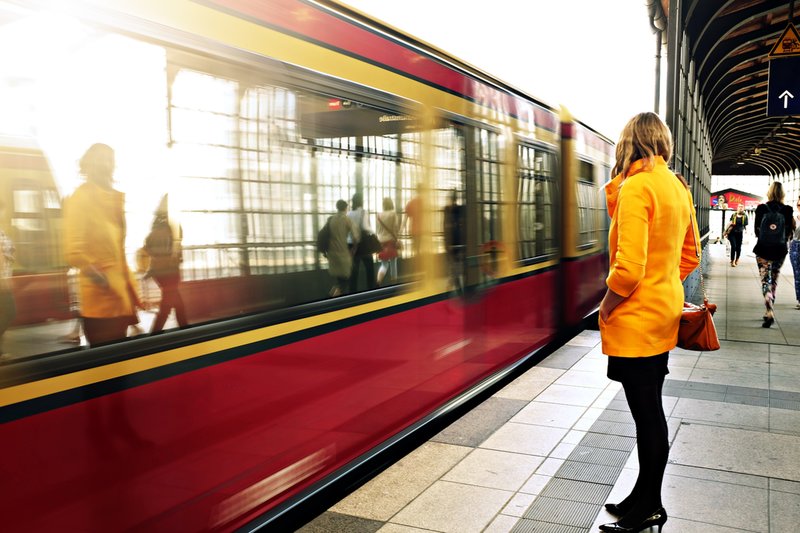Frances Marcellin: What is the main goal of these negotiations?
Libor Lochman: For employers it is important to give a strong signal about the sector’s attention to this topic and willingness to improve the current situation. Our aim is to achieve a concrete and well-targeted agreement, with
workable measures that can be implemented by all the parties involved in favour of female employees in the railway companies.
FM: How are the CER and ETF working together?

A demonstration of the Adaptable Carriage
Ester Caldana: With ETF, we have a long-standing habit of working together in the framework of the European Sectoral Social Dialogue Committee for Railways. At the margins of the actual negotiations, we put in place regular exchanges with experts to make the process run.
Our teams feature a very good mix of expertise from the membership that reflect the diversity of topics negotiated and the specific skills needed in social partners’ negotiations.
FM: What topics are being negotiated?
LL: We focus our negotiations on those areas that can make railways attractive to women, increase their presence inside companies and ensure equal opportunities in all circumstances.
These objectives are achieved starting from the general company framework and policies, which are then developed into more specific areas, such as recruitment, promotion and career development, equal pay, work-life balance, the prevention of sexual harassment and sexism, and health and safety aspects.
FM: What are the leading factors behind the lack of women workers in the rail industry?
EC: There are several root causes, also connected to the more general role and level of involvement of women in society and the family sphere. For technical and STEM professions, the under-representation of women is often a direct consequence of the scarcity of female students in schools and curricula leading to those careers, from where companies usually draw their candidates.
In addition, some professions in particular are still not considered as a career choice by female students and graduates. This is due to their misleading identification as “men’s jobs”, a more general lack of awareness about the employment and career offer of railway companies, and lack of attractiveness of the sector compared to others that are competing for the same skills.
Companies play their role to change this situation. For instance, when they reach out to students and young graduates to present railway jobs and when they put at the forefront [female] employees that work in areas where men still prevail: these activities are an effective tool to show that women can and do work in all types of professions. Technological changes and new ways of working are also improving working conditions, making jobs more accessible to all.
FM: Why do you think an agreement of this nature is important for increasing the number of women in the industry?
LL: The fact that railway employers and trade unions have started negotiations is already an important sign that both sides take the issue seriously. We want to increase the proportion of women in the sector and make them better represented and integrated, and hence willing to stay with the company in the long term.
At [a] European level, we have worked on this topic for many years via other tools, such as joint recommendations, studies and regular monitoring of quantitative and qualitative indicators. These actions have brought positive results, but there is still progress to be made. Women are currently under-represented in the sector as a whole and in some professional categories in particular. Compared to other methods, a European social partner’s agreement implies a higher level of commitment from the side of companies, as well as trade unions to implement the proposed measures.
FM: Why is increasing the number of female workers in the railway industry so important?
EC: Railways can only benefit from the integration of more women. It is a loss for the sector not to benefit from the contribution of qualified women, especially as there are no objective reasons or barriers to their integration. Several
studies have demonstrated that a more diverse workforce is up to six times more innovative and can bring several benefits to a company’s work and culture.
One of the most recent ones is the study commissioned by DG MOVE [the European Commission's Directorate-General for Mobility and Transport] about the business case to employ more women in the transport sector. Considering the demographic trends and their ageing workforce, companies can avoid labour shortages in the future if they are able to recruit also among young people and women, and to retain them in the long term. It is also important for the sector’s image to reflect the diversity of its clients, and, eventually, efforts to attract more women benefit the whole society!
FM: What would the best practices for CER members developing a more balanced gender workforce?
LL: Our members have many initiatives in place that aim to attract and retain more women thanks to an improved working environment and working conditions.
It is often a mix of tools that are put in place: from targeted recruitment and communication campaigns to company HR policies that aim to facilitate the reconciliation between work and family-related duties through solutions that take into account the specificities of the sector (for example, shift work and around-the-clock services).
Company agreements negotiated with employees’ representatives and cooperation with trade unions within bipartite bodies at company level are also valuable tools when it comes to gender equality and equal opportunities matters.
Many good practices applied by CER members can be found in the 2012 Women in Rail Good Practices and Implementation Guide, and more recent examples are described in the CER-ETF Women in Rail reports, the DG MOVE business case study, and on the page of the Women in Transport – EU Platform for Change.
At EU level, the Women in Transport platform, in which CER and our members are actively involved, is itself a good practice as a forum for exchange and cross-fertilisation between the different transport modes.
